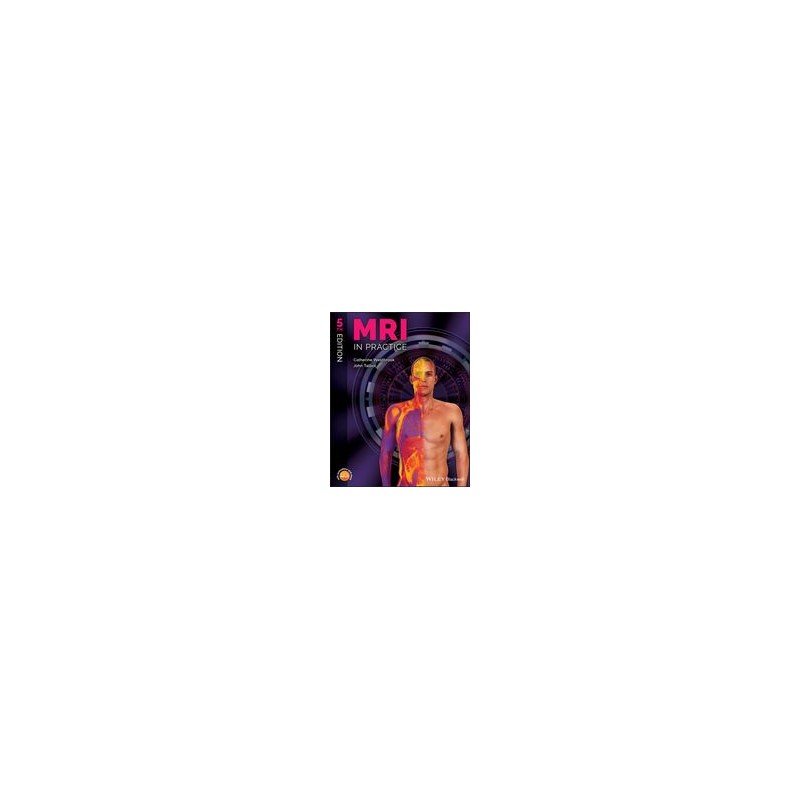- Obniżka


 Dostawa
Dostawa
Wybierz Paczkomat Inpost, Orlen Paczkę, DHL, DPD, Pocztę, email (dla ebooków). Kliknij po więcej
 Płatność
Płatność
Zapłać szybkim przelewem, kartą płatniczą lub za pobraniem. Kliknij po więcej szczegółów
 Zwroty
Zwroty
Jeżeli jesteś konsumentem możesz zwrócić towar w ciągu 14 dni*. Kliknij po więcej szczegółów
MRI in Practice continues to be the number one reference book and study guide for the registry review examination for MRI offered by the American Registry for Radiologic Technologists (ARRT). This latest edition offers in-depth chapters covering all core areas, including:: basic principles, image weighting and contrast, spin and gradient echo pulse sequences, spatial encoding, k-space, protocol optimization, artefacts, instrumentation, and MRI safety.
MRI in Practice is an important text for radiographers, technologists, radiology residents, radiologists, and other students and professionals working within imaging, including medical physicists and nurses.
Opis
Preface to the Fifth Edition ix
Acknowledgments xi
List of Acronyms xiii
Equation symbols xvii
About the Companion Website xix
Chapter 1 Basic principles 1
Introduction 1
Atomic structure 2
Motion in the atom 2
MR active nuclei 4
The hydrogen nucleus 5
Alignment 6
Net magnetic vector (NMV) 8
Precession and precessional (Larmor) frequency 10
Precessional phase 13
Resonance 13
MR signal 18
The free Induction decay(FDI) signal 20
Pulse timing parameters 22
Chapter 2 Image weighting and contrast 24
Introduction 24
Image contrast 25
Relaxation 25
T1 recovery 26
T2 decay 27
Contrast mechanisms 31
Relaxation in different tissues 32
T1 contrast 36
T2 contrast 40
Proton density contrast 41
Weighting 42
Other contrast mechanisms 51
Chapter 3 Spin echo pulse sequences 58
Introduction 58
RF rephasing 59
Conventional spin echo 65
Fast or turbo spin echo FSE/TSE) 68
Inversion recovery (IR) 78
Short tau inversion recovery (STIR) 82
Fluid attenuated inversion recovery (FLAIR) 84
Chapter 4 Gradient echo pulse sequences 89
Introduction 89
Variable flip angle 90
Gradient rephasing 91
Weighting in gradient echo pulse sequences 94
Coherent or rewound gradient echo 106
Incoherent or spoiled gradient echo 109
Reverse-echo gradient echo 113
Balanced gradient echo 119
Fast gradient echo 122
Echo planar imaging (EPI) 122
Chapter 5 Spatial encoding 128
Introduction 128
Mechanism of gradients 129
Gradient axes 134
Slice-selection 135
Frequency encoding 142
Phase encoding 145
Bringing it all together – pulse sequence timing 152
Chapter 6 k-space 158
Introduction 158
Part 1 – what is k-space? 159
Part 2 - how are data acquired and how are images created from this data? 165
Part 3 –some important facts about k-space 184
Part 4:: how do pulse sequences fill k-space? 197
Part 5:: options that fill k-space 199
Chapter 7 Protocol optimization 209
Introduction 209
Signal-to-noise ratio (SNR) 210
Contrast-to-noise ratio (CNR) 226
Spatial resolution 232
Scan time 237
Trade-offs 238
Protocol development and modification 238
Chapter 8 Artefacts 242
Introduction 242
Phase mismapping 243
Aliasing 253
Chemical shift artefact 261
Out-of-phase signal cancellation 265
Magnetic susceptibility artefact 269
Truncation artefact 272
Cross-excitation/cross-talk 273
Zipper artefact 275
Shading artefact 276
Moiré artefact 277
Magic angle 279
Equipment faults 280
Flow artefacts 280
Flow-dependent (non-contrast enhanced) angiography 298
Black-blood imaging 303
Phase contrast MRA 304
Chapter 9 Instrumentation 311
Introduction 311
Magnetism 313
Scanner configurations 315
Magnet system 318
Magnet shielding 326
Shim system 328
Gradient system 330
RF system 337
Patient transport system 343
Computer system and graphic user interface 344
Chapter 10 MRI safety 346
Introduction (and disclaimer) 346
Definitions used in MRI safety 347
Psychological effects 350
The spatially-varying static field 351
Electromagnetic (radiofrequency) fields 357
Time-Varying Gradient Magnetic Fields 363
Cryogens 365
Safety tips 367
Additional resources 368
Glossary 370
Index 387
Indeks: 57792
Autor: David J. Terris
Indeks: 20720
Autor: Przemysław Oszukowski
Repetytorium
